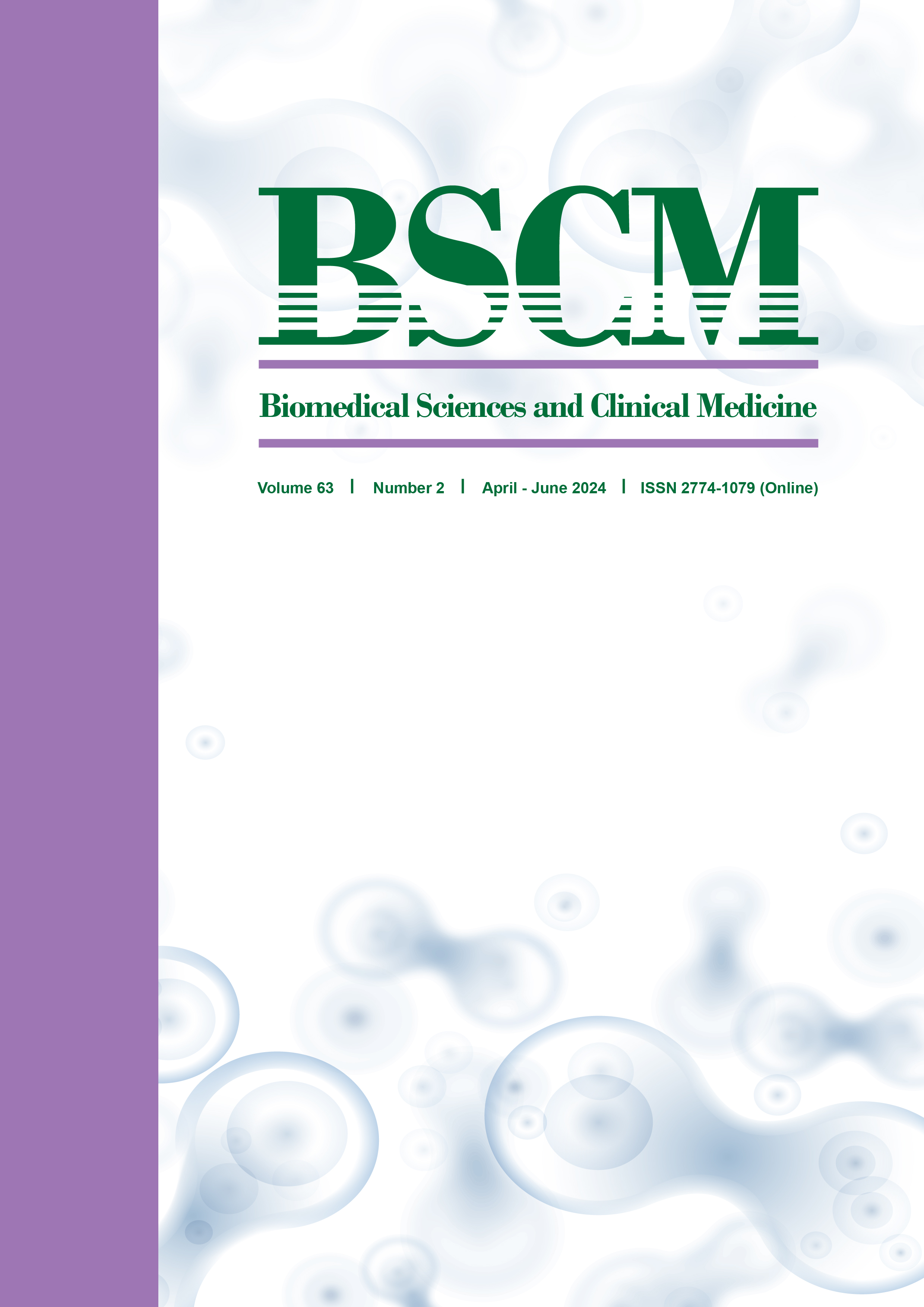Estimation of Post-mortem Interval Based on Livor Mortis using a Colorimeter in Thai Populations
Main Article Content
Abstract
OBJECTIVE Livor mortis is a helpful and widely used method of estimating postmortem interval (PMI) in Thailand. This study aimed to investigate the value of a colorimeter as a tool for estimating the PMI.
METHODS The color of livor mortis and control skin in 80 cadavers whose PMI was within 12 hours was measured by a colorimeter. The L* (brightness), a*b* (chroma and hue), and ΔE* values were compared to the control skin values. Statistical analysis was performed to determine the relationship between PMI and skin color before and after application of a specific pressure.
RESULTS The results showed that colorimetric parameters were only weakly correlated with the PMI. An univariable analysis of ΔE* values was performed and showed good discriminatory power, with an area under the ROC curve of 0.82. The recommended cut-off value of ΔE* was 14 for the discrimination between early PMI (less than 6 hours) and late PMI (6-12 hours), in which the sensitivity and specificity were 72.5% and 80%.
CONCLUSIONS The findings in this study reinforce the utility of colorimetric measurements in PMI estimation. With additional study and a larger sample size, the estimation of PMI could be established for general use in forensic practice.
Article Details

This work is licensed under a Creative Commons Attribution 4.0 International License.
References
Cockle D, Bell L. Human decomposition and the reliability of a ‘Universal’ model for post-mortem interval estimations. Forensic Sci Int. 2015;253:136.e1-9. PubMed PMID: 26092190
Gelderman H, Boer L, Naujocks T, IJzermans A, Duijst W. The development of a post-mortem interval estimation for human remains found on land in the Netherlands. Int J Legal Med. 2018;132:863-73.
Tozzo P, Amico I, Delicati A, Toselli F, Caenazzo L. Post-mortem Interval and Microbiome Analysis through 16S rRNA Analysis: A Systematic Review. Diagnostics (Basel). 2022;12: 2641. PubMed PMID: 36359484
Henssge C, Madea B. Determination of the time since death I: Body heat loss and classical signs of death. An integrated approach. Acta Med Leg Soc. 1988;38:71-89.
Madea B, Henssge C, Honig W, Gerbracht A. References for determining the time of death by potassium in vitreous humor. Forensic Sci Int. 1989;40:231-43.
Zapico SC, Adserias-Garriga J. Postmortem Interval Estimation: New Approaches by the Analysis of Human Tissues and Microbial Communities’ Changes. Forensic Sci. 2022;2:163-74.
Henssge C, Madea B. Estimation of the time since death in the early postmortem period. Forensic Sci
Int. 2004;144:167–75.
Madea B, Knight B. Postmortem lividity, hypostasis and timing of death. In: Madea B, editor. Estimation of the time since death. 3rd ed. Boca Raton, FL: CRC Press; 2016. p. 59-62.
Saukko P, Knight B. The pathophysiology of death. In: Saukko P, Knight B, editors. Knight’s forensic pathology. 4th ed. Boca Raton, FL: CRC Press; 2016. p. 55-93.
Henssge C, Madea B, Gallenkemper E. Death time estimation in case work. II. Integration of different
methods. Forensic Sci Int. 1988;39:77-87.
Vanezis P. Assessing hypostasis by colorimetry. Forensic Sci Int. 1991;52:1-3.
Kaatsch H, Stadler M, Nietert M. Photometric measurement of color changes in livor mortis as a function of pressure and time. Development of a computeraided system for measuring pressure-induced blanching of livor mortis to estimate time of death. Int J Leg Med. 1993;106:91-7.
Kaatsch H, Schmidtke E, Nietsch W. Photometric measurement of pressure-induced blanching of livor
mortis as an aid to estimating time of death. Application of a new system for quantifying pressure-induced blanching in lividity. Int J Leg Med. 1994;106:209-14.
Inoue M, Suyama A, Matuoka T, Inoue T, Okada K, Irizawa Y. Development of an instrument to measure postmortem lividity and its preliminary application to estimate the time since death. Forensic Sci Int. 1994; 65:185-93.
Vanezis P, Trujillo O. Evaluation of hypostasis using a colorimeter measuring system and its application to assessment of the post-mortem interval (time of death). Forensic Sci Int. 1996;78:19-28.
Bohnert M, Weinmann W, Pollak S. Spectrophotometric evaluation of postmortem lividity. Forensic Sci Int. 1999;99:149-58.
Usumoto Y, Hikiji W, Sameshima N, Kudo K, Tsuji A, Ikeda N. Estimation of postmortem interval based on the spectrophotometric analysis of postmortem lividity. Leg Med (Tokyo). 2010;12:19-22.
Romanelli MC, Marrone M, Veneziani A, Gianciotta R, Leonardi S, Beltempo P, et al. Hypostasis and time since death: State of the art in Italy and a novel approach for an operative instrumental protocol. Am J Forensic Med Pathol. 2015;36:99-103.
Simmons T, Adlam R, Moffatt C. Debugging decomposition data- comparative taphonomic studies and the influence of insects and carcass size on decomposition rate. J Forensic Sci. 2010;55:8-13.
Fitzgerald C, Oxenham M. Modelling time-sincedeath in Australian temperature conditions. Aust J
Forensic Sci. 2009;41:27-41.
Myburgh J, L’Abbé E, Steyn M, Becker P. Estimating the postmortem interval (PMI) using accumulated degree-days (ADD) in a temperate region of South Africa. Forensic Sci Int. 2013;229:165.e1-6. PubMed PMID: 23601149
Bass W. Outdoor decomposition rates in Tennessee. in: Haglund WD, Sorg MH, editors. Forensic taphonomy: The postmortem fate of human remains. Boca Raton, FL: CRC Press Taylor & Francis Group; 1997. p.181–6.
Hayman J, Oxenham M. Estimation of the time since death: Current research and future trends. London, UK: Academic Press; 2020.
Kottek M, Jurgen G, Beck C, Rodolf B, Rubel F. World map of the Köppen-Geiger climate classification updated. Meteorol Z. 2006;15:259-63.
Chardon A, Cretois I, Hourseau C. Skin colour typology and suntanning pathways. Int J Cosmet Sci. 1991; 13:191-208.
Mokrzycki W, Tatol M. Color difference Delta E- A survey. Mach Graph Vis. 2011;20:383-411.
Del Bino S, Bernerd F. Variations in skin colour and the biological consequences of ultraviolet radiation exposure. Br J Dermatol. 2013;169(Supplement_3):33-40.


